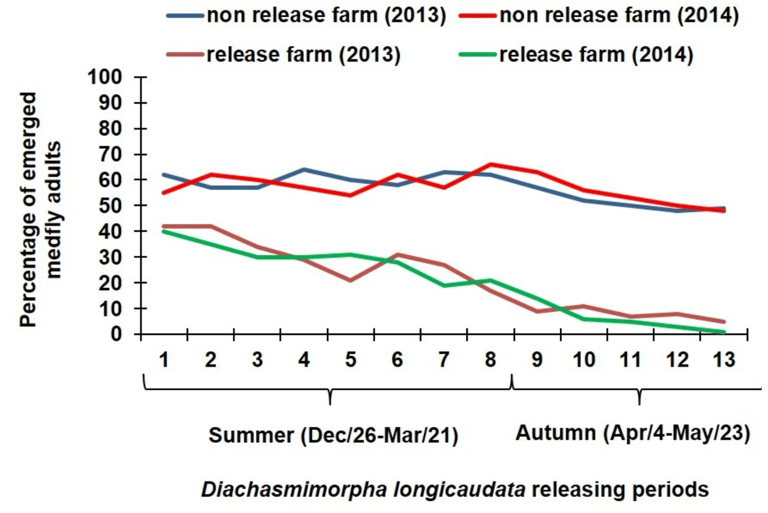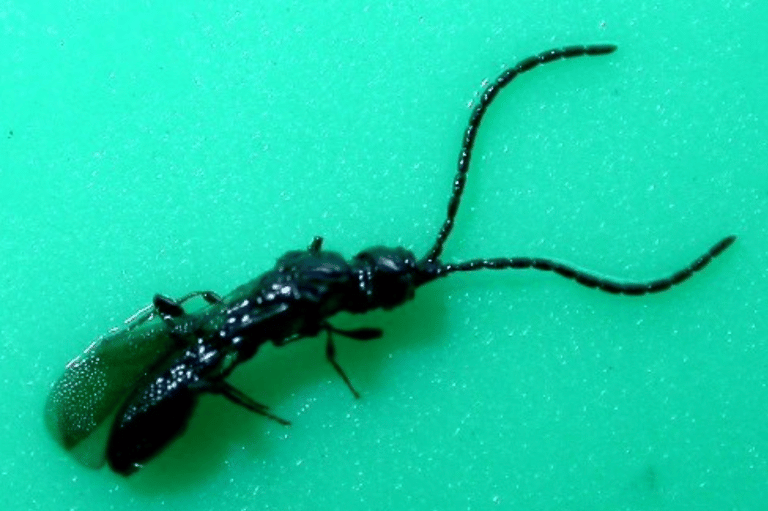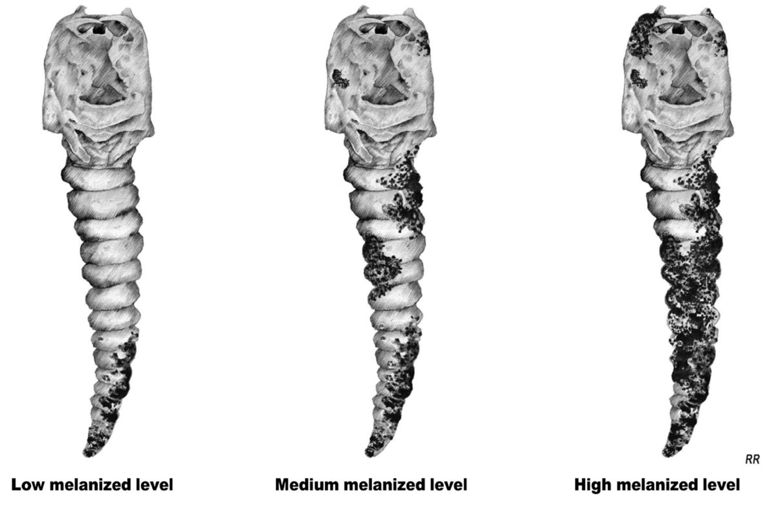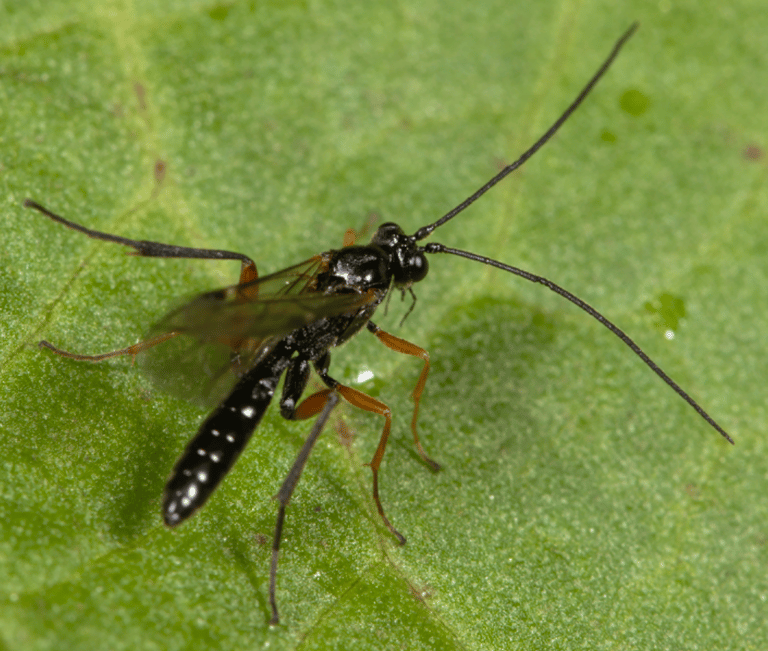Parasitoid Wasps
Núñez-Campero SR, Suárez L, Buonocore Biancheri MJ, Cancino J, Murúa F, Molina D, ..., & Ovruski S M. 2020
Host suitability and fitness-related parameters in Coptera haywardi (Hymenoptera: Diapriidae) reared on irradiated Ceratitis capitata(Diptera: Tephritidae) pupae stemming from the tsl Vienna-8 genetic sexing strain.
Journal of Economic Entomology 113, 1666-1674.
Coptera haywardi (Ogloblin) is a pupal endoparasitoid of tephritid flies with great potential as a biological control agent worldwide as it does not attack other Diptera. To reach its full potential, its mass rearing needs to be enhanced lowering costs. Here, we focused on the use of irradiated pupae of Ceratitis capitata (Wiedemann) stemming from the temperature-sensitive lethal (tsl) Vienna-8 genetic sexing strain (= CcVienna-8), which is mass-produced in the San Juan Medfly and Parasitoid Mass Rearing Facility in Argentina. Exposure of 1- to 2-d-old CcVienna-8 pupae irradiated at 90 Gy to 6- to 8-d-old C. haywardi females at a 10:1 host/parasitoid ratio for 24 h turned out to be highly successful for the rearing of this parasitoid. High radiation doses (90–100 Gy) did not adversely influence fitness parameters of C. haywardi offspring F1, namely lifetime reproductive rates, adult life expectancy, and survival time. Demographic parameters in C. haywardi F1 from irradiated CcVienna-8 young pupae were improved compared to those values recorded from parasitoid originated from nonirradiated CcVienna-8 pupae. These findings will help to enhance parasitoid mass rearing for augmentative releases against medfly in Argentinean fruit-producing regions.






Suárez L, Buonocore Biancheri MJ, Murúa F, Ordano M, Wang X, Cancino J, ..., & Ovruski SM. 2023
Medfly population suppression through augmentative release of an introduced parasitoid in an irrigated multi-fruit orchard of central-western Argentina.
Insects 14, 387.
Biological control through the augmentative release of parasitoids is an important complementary tool that may be incorporated into other strategies for the eradication/eco-friendly control of pest fruit flies. However, not much information is available on the effectiveness of fruit fly parasitoids as biocontrol agents in semi-arid and temperate fruit-growing regions. Therefore, this study evaluated the effect of augmentative releases of the larval parasitoid Diachasmimorpha longicaudata (Ashmead) on Ceratitis capitata (Wiedemann) (medfly) populations over two fruit seasons (2013 and 2014) on a 10 ha irrigated fruit farm in San Juan province, central–western Argentina. The parasitoids were mass reared on irradiated medfly larvae of the Vienna-8 temperature-sensitive lethal genetic sexing strain. About 1,692 (±108) parasitoids/ha were released per each of the 13 periods throughout each fruit season. Another similar farm was chosen as a control of non-parasitoid release. The numbers of captured adult flies in food-baited traps and of recovered fly puparia from sentinel fruits were considered the main variables to analyze the effect of parasitoid release on fly population suppression using a generalized least squares model. The results showed a significant decrease (p < 0.05) in the medfly population on the parasitoid release farm when compared to the Control farm, demonstrating the effectiveness of augmentative biological control using this exotic parasitoid. Thus, D. longicaudata could be used in combination with other medfly suppression strategies in the fruit production valleys of San Juan.
Gadea SLC, Suárez L, Buonocore Biancheri MJ, Murúa F, Molina D, Laría O, & Ovruski S M. 2020.
Effects of exposure time and ratio of irradiated larvae from three medfly strains on progeny yield in Diachasmimorpha longicaudata (Hymenoptera: Braconidae) mass rearing.
Biocontrol Science and Technology 30, 592-601.
An augmentative biological control strategy against Ceratitis capitata (= medfly) in fruit-producing irrigated-valleys of San Juan, central-western Argentina, has been recently implemented by the San Juan Fruit Fly Control and Eradication Program. The Asian-native parasitoid Diachasmimorpha longicaudata is currently reared at the San Juan Medfly and Parasitoids Mass Rearing Facility for this purpose. In this regard, the objective of this study was to evaluate adult emergence and offspring sex ratio to improve parasitoid production. Three medfly strains at different host larvae densities and exposure times to female parasitoids were assessed. Prevalence of superparasitism was also considered. Three parasitoid population lines were used in the trials: one reared on medfly larvae of the Vienna-8 temperature-sensitive lethal (tsl) genetic sexing strain without inversion, and the other two on larvae of biparental medfly strains native to San Juan (central-western Argentina) and Tucumán (northwestern Argentina). Gamma-irradiated 6 d-old larvae (early third-instars) of each medfly strain were exposed to parasitoids for 30, 60, 90, and 120 min at 3:1, 6:1, and 9:1 host/parasitoid ratios. The Vienna-8 C. capitata strain was as efficient in producing parasitoids as both biparental native strains. Medfly larvae exposed to 10 female parasitoids for a relatively long time (1.30 hrs) at a high ratio (6–9:1) of host to parasitoid were enough to achieve the highest mean adult emergence (50–60%) and a female-biased offspring sex ratio. Superparasitism positively influenced female parasitoid production. These findings may be used to develop a more cost-effective mass rearing method for D. longicaudata.
Suárez L, Buonocore Biancheri MJ, Sánchez G, Cancino J, Murúa F, Bilbao M, ..., & Ovruski S M. 2020
Radiation on medfly larvae of tsl Vienna-8 genetic sexing strain displays reduced parasitoid encapsulation in mass-reared Diachasmimorpha longicaudata (Hymenoptera: Braconidae).
Journal of Economic Entomology 113, 1134-1144.
Improvements in the mass rearing of Diachasmimorpha longicaudata (Ashmead) on larvae of the Vienna-8 temperature-sensitive lethal genetic sexing strain of Ceratitis capitata (Wiedemann) (Diptera: Tephritidae) (= GSS Vienna-8) at the San Juan biofactory, Argentina, are currently under way. Lowering cost production is a key factor regarding parasitoid rearing. Thus, the variation in mass-reared parasitoid encapsulation levels and the incidence of superparasitism were determined; also, the gamma radiation dose-effect relation on host larvae and the influence of Mediterranean fruit fly strain were considered. Naked Mediterranean fruit fly larvae of both GSS Vienna-8 and a wild bisexual strain (= WBS) aged 6-d-old were irradiated at 0, 20, 40, 60, 80, 100, and 120 Gy, and exposed to parasitoid females. Melanization level was tested for encapsulated parasitoid larval first-instars (= L1). Non-irradiated and irradiated WBS larvae at 20–40 Gy displayed a significantly higher incidence of encapsulation when compared with GSS Vienna-8 larvae. The low melanized level in encapsulated parasitoid L1 was the most common melanization process at 72 h puparium dissection. A high melanized level was only found in non-irradiated WBS larvae. Irradiated GSS Vienna-8 larvae can neutralize the host immunological reactions over irradiated WBS larvae much more quickly. Superparasitism intensity in both Mediterranean fruit fly strains was not affected by radiation doses. High levels of superparasitism seemingly helped to overcome the host’s immune reaction by the surviving parasitoid larva. Parasitoid emergence increased from 60 Gy onwards in both Mediterranean fruit fly strains. Radiation in GSS Vienna-8 larvae may favor host’s antagonistic reactions decrease in relation with D. longicaudata development.


Image: Magnus Hagdorn
Suárez L, Buonocore Biancheri MJ, Sánchez G, Murúa F, Funes CF, Kirschbaum DS, ..., & Ovruski SM. 2019
Effects of releasing two Diachasmimorpha longicaudata population lines for the control of Ceratitis capitata infesting three key host fruit species.
Biological Control 133, 58-65.
Suárez L, Buonocore Biancheri MJ, Murúa F, Bilbao M, García M, Cancino J, ..., & Ovruski SM. 2019
Effects of host age and radiation dose in Diachasmimorpha longicaudata (Hymenoptera: Braconidae) mass-reared on medfly larvae of the tsl Vienna 8 genetic sexing strain.
Biological Control 130, 51-59.
Suárez L, Buonocore Biancheri MJ, Sánchez G, Murúa F, Funes CF, Kirschbaum DS, …, & Ovruski SM. 2019
Desempeño de Diachasmimorpha longicaudata (Hymenoptera: Braconidae) criado masivamente sobre la cepa de sexado genético tsl Vienna-8 de Ceratitis capitata (Diptera: Tephritidae) y liberado contra Anastrepha fraterculus (Diptera: Tephritidae) en condiciones de semi-campo [Performance of Diachasmimorpha longicaudata (Hymenoptera: Braconidae) mass-reared on the genetic sexing strain tsl Vienna-8 of Ceratitis capitata (Diptera: Tephritidae) and released against Anastrepha fraterculus (Diptera: Tephritidae) under semi-field conditions].
Revista de la Facultad de Agronomía de la Universidad Nacional de La Pampa 29 (supl.), 34-35.
Sánchez G, Murúa F, Suárez L, Van Nieuwenhove G, Taret G, Pantano V, ..., & Ovruski SM. 2016
Augmentative releases of Diachasmimorpha longicaudata (Hymenoptera: Braconidae) for Ceratitis capitata (Diptera: Tephritidae) control in a fruit-growing region of Argentina.
Biological Control 103, 101-107.
Suárez L, Murúa F, Lara N, Escobar J M, Taret G, Rubio JL, …, Ovruski SM. 2014
Biological control of Ceratitis capitata (Diptera: Tephritidae) in Argentina: Releases of Diachasmimorpha longicaudata(Hymenoptera: Braconidae) in fruit-producing semi-arid areas of San Juan.
Natural Science 6, 664-675.
Murúa F, Suárez L, Taret G, Sánchez G, García M, Bilbao M, ..., & Ovruski SM. 2013
Avances en el desarrollo del control biológico mediante el empleo del parasitoide Diachasmimorpha longicaudatad(Hymenoptera: Braconidae) en un programa de manejo integrado de omoscas de la fruta en San Juan [Advances in the development of biological control using Diachasmimorpha longicaudata (Hymenoptera: Braconidae) in a fruit fly integrated management program in San Juan Province].
Acta Zoologica Lilloana 57, 46-47.
Suárez L, Van Nieuwenhove G A, Murúa F, Bezdjian L P, Schliserman P, Lara N, ..., & Ovruski SM. 2012
Offspring production in response to host exposure times in Diachasmimorpha longicaudata (Hymenoptera: Braconidae), reared on the genetic sexing strain Vienna 8 of Ceratitis capitata (Diptera: Tephritidae).
Florida Entomologist 95, 991-999.
Brewer M, Gorla D, Murúa F, & Favot R. 1984
Sobre la biologia en laboratório de cuatro especies de parasitoides oofagos de Triatoma infestans Klug, 1834 (Hemiptera, Reduviidae) [On the laboratory biology of four species of oophagous parasitoids of Triatoma infestans (Hemiptera, Reduviidae)].
Anais da Sociedade Entomológica do Brasil 13, 339-355.
Brewer M, Gorla D, & Murúa F. 1981
Nuevo aporte al conocimiento de parasitoides oofagos de Triatoma infestans Klug, 1834 (Hemiptera, Reduviidae), en Cruz del Eje, Cordoba, Republica Argentina [Parasitoids of Triatoma infestans eggs (Hemiptera, Reduviidae) in Cruz del Eje, Cordoba, Argentina].
Anais da Sociedade Entomológica do Brasil 10, 175-186.